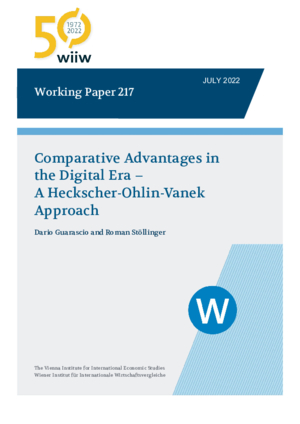Comparative Advantages in the Digital Era – A Heckscher-Ohlin-Vanek Approach
Dario Guarascio and Roman Stöllinger
wiiw Working Paper No. 217, July 2022
37 pages including 9 Tables and 6 Figures
This paper revisits the Heckscher-Ohlin-Vanek (HOV) theorem and investigates its fit for digital tasks and ICT capital, which both represent endowment factors that are expected to shape the digital transformation. We use a theory-consistent methodology for calculating the measured net factor content of trade (Trefler and Zhu, 2010) and apply it to a unique dataset on digital and non-digital tasks performed in detailed occupations, as well as recent data on ICT capital stocks. Equipped with these data we provide new evidence on the factor-based trade patterns for 25 EU countries and use it to test the HOV theorem. Overall, the performance of the sign test and the rank test is good if not impressive. In 83% of the cases countries are net exporters of those factors with which they are abundantly endowed, with a higher score achieved for digital tasks than for ICT capital. We conclude that the fit of the HOV theorem for highly relevant endowments of the digital era is as good as that of traditional endowment factors.
Keywords: Heckscher-Ohlin-Vanek theorem, factor content of trade, comparative advantages, digital tasks, ICT capital
JEL classification: F11; F14; D57
Countries covered: Austria, Belgium, Bulgaria, Croatia, Cyprus, Czechia, Denmark, Estonia, Finland, France, Germany, Greece, Hungary, Ireland, Italy, Latvia, Lithuania, Luxembourg, Malta, Netherlands, Poland, Portugal, Romania, Slovakia, Slovenia, Spain, Sweden, United Kingdom, EU
Research Areas: International Trade, Competitiveness and FDI
